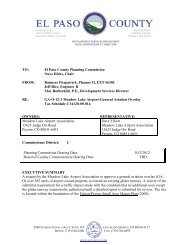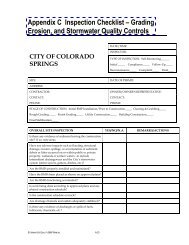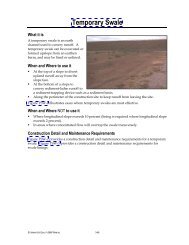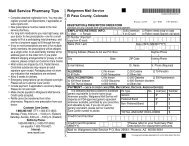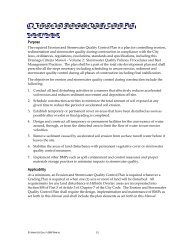Playing by the Rules: A Handbook for CDBG ... - City of El Cajon
Playing by the Rules: A Handbook for CDBG ... - City of El Cajon
Playing by the Rules: A Handbook for CDBG ... - City of El Cajon
Create successful ePaper yourself
Turn your PDF publications into a flip-book with our unique Google optimized e-Paper software.
<strong>Playing</strong> <strong>by</strong> <strong>the</strong> <strong>Rules</strong><br />
A <strong>Handbook</strong> <strong>for</strong> <strong>CDBG</strong> Subrecipients on Administrative Systems<br />
• Documentation <strong>of</strong> compliance, as applicable, with historic preservation, flood insurance,<br />
lead-based paint, Davis-Bacon, relocation/anti-displacement, and o<strong>the</strong>r relevant program<br />
rules.<br />
• Evidence <strong>of</strong> <strong>the</strong> subrecipient’s periodic on-site inspection and sign-<strong>of</strong>f on rehabilitation<br />
work, including final inspection.<br />
• Copies <strong>of</strong> all change orders, with proper authorization.<br />
• Records <strong>of</strong> disbursements made <strong>for</strong> completed and approved work. (In regard to this last<br />
item, a subrecipient must ensure that <strong>the</strong> data in its project files agree with its financial<br />
records.)<br />
For each type <strong>of</strong> activity undertaken, a subrecipient in consultation with <strong>the</strong> grantee should<br />
determine <strong>the</strong> comparable data that must be maintained in <strong>the</strong> individual case files and establish<br />
a system <strong>for</strong> ensuring that every file contains <strong>the</strong> necessary in<strong>for</strong>mation. Although <strong>the</strong> list will<br />
vary from activity to activity, each project or case file should include documentation <strong>of</strong> <strong>the</strong><br />
National Objective being met, <strong>the</strong> characteristics and location <strong>of</strong> beneficiaries, <strong>the</strong> eligibility<br />
<strong>of</strong> <strong>the</strong> activity, <strong>the</strong> compliance with special program requirements, <strong>the</strong> allowability <strong>of</strong> <strong>the</strong><br />
costs, and <strong>the</strong> status <strong>of</strong> <strong>the</strong> case/project.<br />
A subrecipient must also devote attention to implementing an efficient method <strong>for</strong> compiling<br />
cumulative data on its activities <strong>for</strong> inclusion in periodic reports required <strong>by</strong> <strong>the</strong> grantee. The<br />
subrecipient should develop logs <strong>for</strong> recording and totaling programmatic data (<strong>by</strong> type <strong>of</strong><br />
activity, <strong>for</strong> units <strong>of</strong> service, numbers <strong>of</strong> beneficiaries, etc.) as cases are initiated and as <strong>the</strong>y<br />
progress to avoid searching through all <strong>of</strong> its individual case files to obtain aggregate statistics<br />
every time a progress report is due. The establishment <strong>of</strong> such logs at <strong>the</strong> commencement <strong>of</strong> a<br />
<strong>CDBG</strong> activity, based on <strong>the</strong> reporting requirements specified <strong>by</strong> <strong>the</strong> grantee (see Section 5.5 in<br />
<strong>the</strong> following section), can save a subrecipient considerable time and ef<strong>for</strong>t over <strong>the</strong> course <strong>of</strong> <strong>the</strong><br />
activity.<br />
With an automated reporting system, it is critical to structure <strong>the</strong> computer database to permit <strong>the</strong><br />
collection and manipulation <strong>of</strong> all data elements (i.e., characteristics <strong>of</strong> projects and<br />
beneficiaries) necessary <strong>for</strong> <strong>the</strong> production <strong>of</strong> currently required reports and reports that may be<br />
desired in <strong>the</strong> future. This requires a careful appraisal <strong>of</strong> current and anticipated future operations<br />
and an assessment <strong>of</strong> <strong>the</strong> “interface” between <strong>the</strong> computer system and <strong>the</strong> individuals who will<br />
input <strong>the</strong> data and those who will use <strong>the</strong> generated reports.<br />
Chapter 5–6



